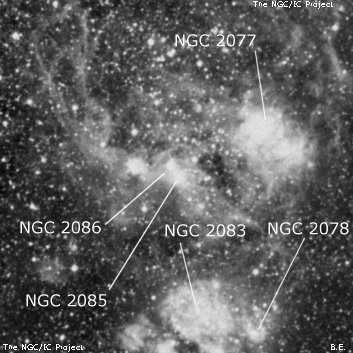
John Herschel discovered NGC 2085 = h2954 on 23 Dec 1834 and reported "a very faint, nearly round nebula close to a star 10th mag, not observed in sweeping, but laid down Dec 4, 1873 in the drawing fig 4, Plate III whence its place is derived." The identification is certain based on his sketch.
600/800mm - 24" (4/9/08 - Magellan Observatory, Australia): this HII knot is part of an amazing field of nebulous glows located ~35' SSE of the Tarantula Nebula. At 200x using a UHC filter, NGC 2085 appears bright, fairly small, ~25" diameter. A mag 10.0 star (supergiant HDE 269953) is just off the NE end (23" from the center). NGC 2085 forms a close pair with NGC 2086 = IC 2145, a similar knot just 1.2' E. Both of these knots are immersed in small, much fainter nebulous halos but the bright star itself does not appear to be involved. Viewing with the filter, the field is divided up into three main groups with NGC 2085 and 2086 forming a close E-W pair separated by a mag 10 star. NGC 2080 (brightest section in the LMC-N159/160 complex) and NGC 2077 lies ~2.5' NW and an impressive cluster of nebulous knots (NGC 2078, 2079, 2083 and 84) is roughly 6' SSW.
Notes by Steve Gottlieb